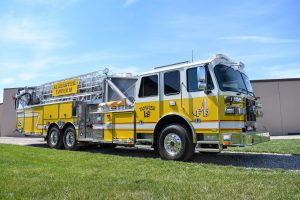Alabaster (AL) Fire Department has been a customer of Sutphen for several years, so when it needed an aerial apparatus to complement the Sutphen engines it already owned, it naturally turned to Sutphen to configure an aerial device that would best suit its needs.
Jerry Harley, sales manager for Alabama, Georgia, and South Carolina at Williams Fire Apparatus, who sold the SPH 100 to Alabaster (along with the pumpers in earlier years), says Alabaster approached him and asked what kind of aerial vehicle could be built that offered fire-suppression capabilities, as well as aerial rescue functions, and could serve in place of a rescue truck.

Sutphen built this SPH 100 aerial platform quint for Alabaster (AL) Fire Department. (Photos 1-5 courtesy of Sutphen Corp.)
“We talked about what their requirements were and the equipment they wanted to carry,” Harley says, “and determined that the SPH 100 aerial platform offered them the best versatility for rescue situations, and massive fire flow through its two monitors on the platform.”

The 100-foot aerial platform quint is powered by a 500-horsepower (hp) Cummins X12 diesel engine and an Allison 4500R EVS automatic transmission.
Harley adds that because the terrain in Alabaster is hilly the department wanted a rig that could handle the geography. “In addition to a Jacobs brake on the truck, they added a transmission retarder that allows them to safely negotiate the hills,” he says. “The gear ratio on the truck is good for hill climbs, allowing good acceleration, and also safe deceleration.”
Tim Love, Alabaster’s chief, notes that the SPH 100 is the largest single apparatus purchase the city has ever made. “The platform gives us the most versatility over a straight ladder,” Love says, “and the 100-foot length gets us to our maximum capabilities. We’re confident that the area won’t out-build the height the aerial can reach over the next 20 years.”
Justin Howell, southern region sales manager for Sutphen, points out the Alabaster SPH 100 is built on a Monarch heavy-duty custom chassis with a 56-inch flat roof, four-door cab set up for five firefighters. He says the rig has a front-axle weight rating of 23,000 pounds, and a rear-axle weight rating of 52,000 pounds. The aerial platform is powered by a 500-horsepower Cummins X12 diesel engine, and an Allison 4500R EVS automatic transmission, with a Leece Neville 320-amp alternator.
Howell notes the rig has a Hale QMax 2,000-gallon-per-minute (gpm) single stage pump, a 300-gallon water tank, two 1-3/4-inch crosslays, and one 2-1/2-inch crosslay. The quint also has two 2-1/2-inch discharges on the left side, and one 4-inch discharge, and one 2-1/2-inch discharge on the right side. Two monitors are on the platform, both Akron 3483 StreamMaster 2 manual 1,250-gpm models.
He says that the body has a mix of rollup and hinged compartment doors that cover more than 280 cubic feet of compartment space, while the vehicle has a 12-inch polished stainless steel bumper, a grill-mounted Federal Q2B siren, a Voyager 2 camera system, a FRC ACT 2-station intercom system, Whelen Freedom IV 72-inch LED light bars, a FRC 12-volt Spectra LED brow light, Whelen 600 warning lights, FRC LED scene lights, and telescoping lights and Unity LED flood lights.
Love points out that the vehicle’s shorter wheelbase at 230 inches is the result of a shorter cab and bumper. “It allows us a lot of maneuverability in Alabaster’s hilly terrain,” Love says, “and we are very pleased with its handling and turning capabilities.”

Alabaster’s SPH 100 has Whelen Freedom IV 72-inch LED light bars, a FRC 12-volt Spectra LED brow light, Whelen 600 warning lights, FRC LED scene lights, telescoping lights and Unity LED flood lights.
ALAN M. PETRILLO is a Tucson, Ariz.-based journalist, the author of three novels and five non-fiction books, and a member of the Fire Apparatus & Emergency Equipment editorial advisory board. He served 22 years with Verdoy (NY) Fire Department, including the position of chief.









